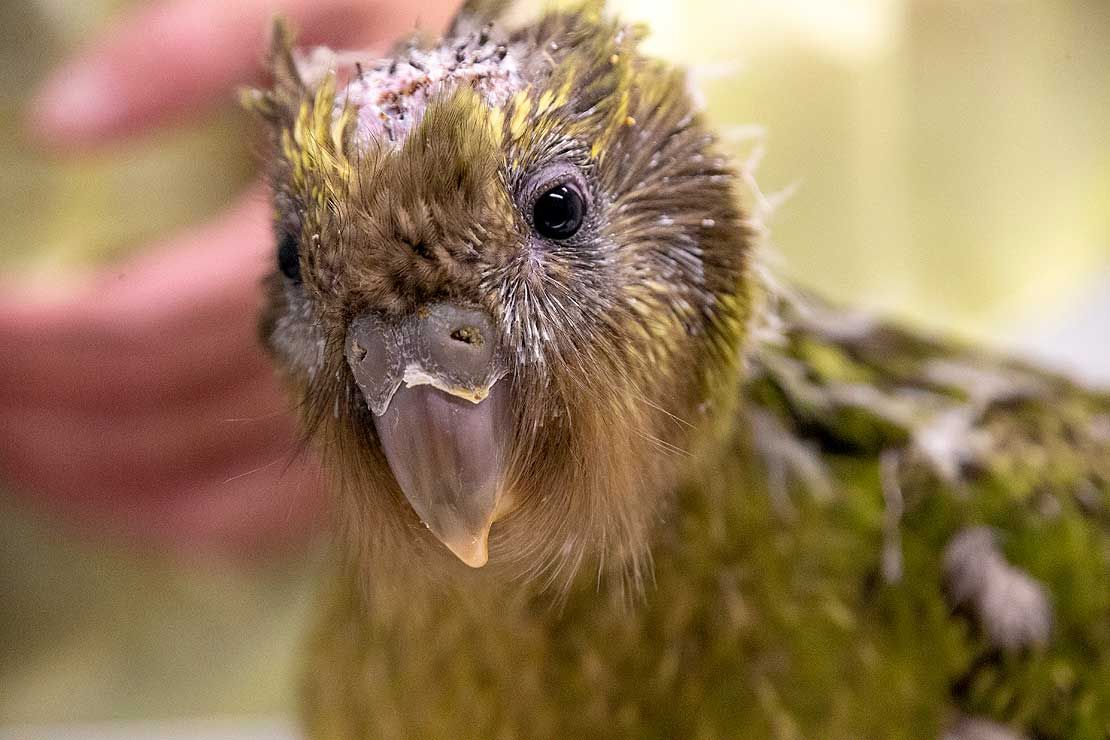
A rare bird chick has received lifesaving surgery at a veterinary hospital in a risky first-of-its-kind procedure.
Surgeons at Massey University Wildbase Hospital in New Zealand treated the 56-day-old kakapo chick, known as Espy 1B, to repair a hole in its skull that had been present since birth.
Kakapos are a species of large, flightless, nocturnal parrots that live on the ground and are found only in New Zealand. They are critically endangered, with only 144 known kakapos remaining, all of which are named.
The chick in question hatched in the wild on tiny Codfish Island (or Whenua Hou)—a predator-free sanctuary off the south coast of New Zealand's South Island, where many of the remaining kakapos are kept. It was in the care of the Department of Conservation's Kakapo Recovery Team when rangers noticed an unusual lump on its skull.
The team sent the chick to a wildlife hospital in Dunedin—a city in the South Island—to receive a CT scan so that the problem could be diagnosed. This revealed that there was only a thin layer of tissue separating the chick's brain from the outside world.
"The CT scan showed that the plates of its skull had not completely fused and the fontanelle was still open," Brett Gartrell, director of Wildbase Hospital, said in a statement. "The chick was hatched with a hole in its skull that allowed part of the brain and dura—the tough barrier around the brain—to herniate out, the technical term for this condition is a meningoencephalocoele.
"In humans, this spot fuses after birth, but this is highly unusual in birds as the skull has finished fusing prior to hatch," he said. "The concern was that if this tissue was damaged this would open the brain to trauma and infection. With only 144 kakapos left in the world, this condition could be life-threatening for the critically endangered bird, so action needed to be taken, but nothing like it had been attempted before in avian medicine."
A team of veterinarians from around New Zealand determined that a type of surgery previously used in humans and mammals—but never before in birds—would be the best treatment option, although Gartrell said that surgeons had to adapt their techniques to suit the peculiarities of bird anatomy.
"This is a risky surgery and the common complications for this surgery in humans include permanent brain damage, continued leakage of cerebrospinal fluid and the possibility of meningitis," he said.
Espy 1B was flown for free by national airline to Wildbase and received the surgery on April 29, with the team, led by Gartrell, reporting that the procedure was a success. The chick has now made a remarkable recovery and is expected to grow into a healthy adult.
Like many birds that are native to one island—or a set of islands—the kakapo has a number of unusual characteristics. For example, it is the only flightless parrot—while also being one of the heaviest. Furthermore, researchers think it may be one of the world's longest-lived birds. In fact, the oldest known kakapo—dubbed "Richard Henry" after a pioneering conservationist—is thought to have died at the grand old age of 80.
The kakapo's relationship with humans has long been troubled. When Polynesian settlers arrived in New Zealand around 700 years ago, they hunted it extensively, no doubt because it was easy prey. The meat was eaten while the feathers were used to make highly-valued clothing.
These settlers first introduced dogs and rats to New Zealand, which also preyed on the bird, according to the Department of Conservation.
Then, with the arrival of Europeans in the 1800s, the kakapo was almost wiped out—to the point where it could only be found in the central North Island and forested parts of the South Island.
Europeans accelerated the reduction in the bird's numbers through the destruction of its habitat via forest clearance, as well as the introduction of possums and deer—which depleted food stocks in forests—and more predators, such as cats, stoats and two other species of rats.
In the 1890s, conservationist Richard Henry led the first effort to try to save the kakapo. However, at the turn of the 20th century, only a few birds remained in isolated parts of the country.
Between the late 1940s and mid-1970s, the country's new Wildlife Service—which would later become the Department of Conservation—conducted numerous expeditions to try to find kakapo, however, only a handful were caught. But then, in 1977, a large population was found on Rakiura Island, that became the foundation for all subsequent conservation efforts.
Although the island was largely free from stoats and weasels, predation by feral cats caused a rapid decline in this population, so conservationists evacuated the birds over the course of the 1980s and 1990s to three sanctuary islands: Codfish Island, Maud Island and Little Barrier Island (Te Hauturu-o-Toi).
In 1996, a special service to help protect the kakapo was formed, and there is now cautious optimism about the future of the species, according to the Department of Conservation.
Uncommon Knowledge
Newsweek is committed to challenging conventional wisdom and finding connections in the search for common ground.
Newsweek is committed to challenging conventional wisdom and finding connections in the search for common ground.
About the writer
Aristos is a Newsweek science reporter with the London, U.K., bureau. He reports on science and health topics, including; animal, ... Read more
To read how Newsweek uses AI as a newsroom tool, Click here.








